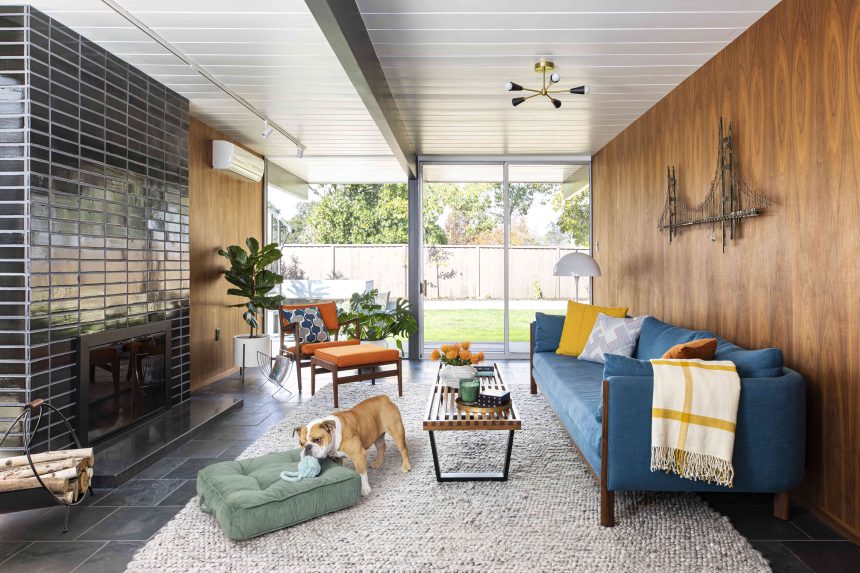The living room is an undeniably precious space in the home—where movie marathons, late-night chats, and special celebrations all take root. So it’s only right that it is decorated accordingly.
From specific layouts of furniture to layering decor, there are certain core tenets designers follow when working with the living room. Ready for a living room revamp yourself?
Ahead, we tapped two interior designers for the six golden roles they always keep in mind when decorating the living room—along with tips to successfully integrate them into your home.
Meet the Expert
- Margaret Carroll is the principal designer and founder of Margaret Carroll Interiors.
- Karen Nepacena is the principal designer and founder of Destination Eichler.
- Sandy Saintilus is an interior designer and home decor content creator.
Choose a Focal Point
Photo by Christopher Dibble / Design by Karen Nepacena
To anchor the living room, interior designer Margaret Carroll likes to bring in a “wow” factor to catch the eye.
“It could be a vintage statement mirror, a larger than normal piece of art, or an architectural element like wood beams that draw your eye upwards,” Carroll says.
“Bold, colorful fireplaces or custom built-ins with personalized books and thoughtfully styled items tie the space together and give it personality,” Carroll adds. “It’s your chance to tell a story or show off your style.”
The focal point doesn’t necessarily have to be decor or an architectural feature, though.
“Plan the seating arrangement to enable cozy conversations,” Karen Nepacena, principal designer and founder of Destination Eichler, says. “It can be overwhelming to layout where furniture goes in a room, but starting with a focal point will help the pieces fall into place.”
Want more design inspiration? Sign up for our free daily newsletter for the latest decor ideas, designer tips, and more!
Make It Personal
It’s easy to get caught up in the aesthetics of your living room, but it’s important that it makes sense for your household, too.
“Decorate your home for how you actually live. Don’t decorate according to trends or magazine pictures—unless they’re practical for your lifestyle,” interior designer Sandy Saintilus says.
A common faux pas is the popular white sofa that has been proliferating on social media feeds.
“They look great but if you aren’t committed to the extra care needed for light-colored furniture in general, you’ll end up hating it,” Saintilus explains.
Combine Old and New
Mixing old and new pieces is a tried and true design technique that works especially well in the living room.
“A room filled with all new or all vintage items can feel one-dimensional, but combining the two creates a conversation between the past and present,” Caroll says.
Carroll recommends starting with a neutral base, like a simple sofa or rug, and then layering in vintage accents like an armchair or trinket.
“Don’t shy away from bold contrasts—pairing a minimalist coffee table with vintage wallpaper,” Caroll says. “The combination of items from different eras in a living room can be visually interesting and striking.”
Layer Your Lighting
Layering lighting is always a good idea, as it creates an inviting ambiance that you and guests alike will enjoy basking in for hours.
“Don’t just rely on the big light—add table lamps, picture lights, and floor lamps,” Saintilus recommends. “Having table lamps or floor lamps within an arm’s reach will be easier to access without having to get up from your seat,” she adds.
Opting for a warm color temperature also helps set the scene.
“One of the most cost-efficient ways to create a cozy room is to make sure your light bulbs are 2700K to 3000K in temperature,” Saintilus says. “This will ensure a warm light instead of super bright hospital lighting.”
Blend Different Textures
Similarly, layering in different textures brings in added depth to the living room.
“Don’t be afraid to mix and match materials, such as wood and glass, leather and upholstery, a stone table with a fiber basket on top,” Nepacena says.
To make the process easier, Nepacena notes that you can find furniture that does the job for you, rather than investing in multiple pieces.
“[For example,] a wood coffee table base with a stone top. Then you are investing in a piece of furniture with visual interest and functionality,” Nepacena says.
Measure Everything
In the living room, there are so many large pieces and passageways that you have to account for. Therefore, measuring your space is a must.
“Measure before you buy to ensure the items will not only fit in your space [but] through doorways and up stairwells, too,” Saintilus says.
Planning ahead will also make it easier to orient your pieces.
“Aside from measuring doorways and stairwells, use painter’s tape to map out where furniture will go to help you visualize how it will fit in your home,” Saintilus suggests.






